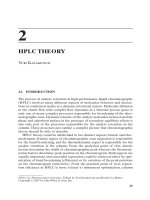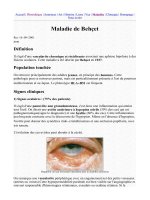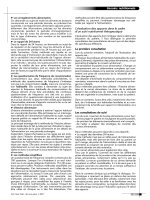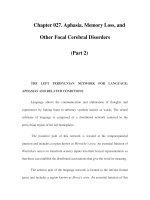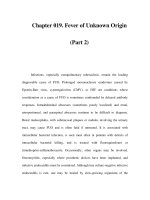Chapter 128. Pneumococcal Infections (Part 2) pptx
Bạn đang xem bản rút gọn của tài liệu. Xem và tải ngay bản đầy đủ của tài liệu tại đây (13.19 KB, 5 trang )
Chapter 128. Pneumococcal Infections
(Part 2)
Nonimmunologic Mechanisms
Nonimmunologic mechanisms that protect against pneumonia include
filtration of air as it passes through the nasopharynx, the glottal reflex, laryngeal
closure, the cough reflex, clearance of organisms from the lower airways by
ciliated cells, and ingestion by pulmonary macrophages and PMNs of small
bacterial inocula that manage to reach alveolar spaces. Respiratory virus infection,
chronic pulmonary disease, or heart failure compromises these mechanisms,
predisposing to the development of pneumococcal pneumonia.
Immunologic Mechanisms
Innate Immunity
Innate immune mechanisms participate in clearance of pneumococci from
the nasopharynx as well as in phagocytosis by PMNs and macrophages via the
microbial pattern recognition receptor Toll-like receptor 2 (TLR2).
Humoral Immunity
Immunologically specific humoral mechanisms provide the best protection
against pneumococcal infection. Most healthy adults have antibody to constituents
of S. pneumoniae, such as PspA, PsaA, and the cell wall; however, there is no
convincing evidence for an opsonic role of these antibodies, especially at their
usual concentrations. Most healthy adults lack IgG antibody to the majority of
pneumococcal capsular polysaccharides. Antibody appears after colonization,
infection, or vaccination. In the first few weeks after colonization, nonspecific
mechanisms probably protect the host from infection. Thereafter, newly developed
anticapsular antibody provides a high degree of specific protection. Adults who
are at risk of aspirating pharyngeal contents and/or who have diminished
mechanisms of lower airway clearance are at risk of developing pneumonia before
antibody is produced. Persons with a diminished capacity to form antibody
probably remain susceptible as long as they are colonized.
The risk of serious pneumococcal infection is greatly increased in persons
with conditions that compromise IgG synthesis and/or the phagocytic function of
PMNs and macrophages. Most patients hospitalized for pneumococcal pneumonia
have one or more of these conditions (Table 128-1). Once a pneumococcal
infection has been initiated, the absence of a spleen predisposes to fulminant
disease. The liver can remove opsonized (antibody-coated) pneumococci from the
circulation; in the absence of antibody, however, only the slow passage of blood
through the splenic sinuses and prolonged contact with reticuloendothelial cells in
the cords of Billroth can result in bacterial clearance. Patients without spleens tend
to develop overwhelming pneumococcal disease that rapidly progresses to death.
Table 128-
1 Conditions that Commonly Predispose to Pneumococcal
Infection
Increased risk of exposure
Day-care centers
Military training camps
Prisons
Shelters for the homeless
Respiratory infection, inflammation
Influenza, other viral respiratory
infections
Air pollution
Allergies
Defective complement
function
Defective bacterial
clearance
a
Congenital asplenia,
hyposplenia
Splenectomy
Sickle cell disease
Multifactorial conditions
Infancy and aging
Cigarette smoking
Chronic obstructive pulmonary disease
Other causes of chronic pulmonary
inflammation or obstruction
Anatomi
cal disruption of meninges
(dural tear)
Defective antibody formation
Common variable
hypogammaglobulinemia
Selective IgG subclass deficiency
Multiple myeloma
Chronic lymphocytic leukemia
Lymphoma
Chronic disease
Alcoholism
Prior hospitalization
Malnutrition
HIV infection
Chronic lung disease
Glucocorticoid treatment
Cirrhosis of the liver
Renal insufficiency
Diabetes mellitus
Anemia
Coronary artery disease
Fatigue, stress, and/or
exposure to cold
a
The absence of a spleen predisposes to more fulminant infection (see text).

